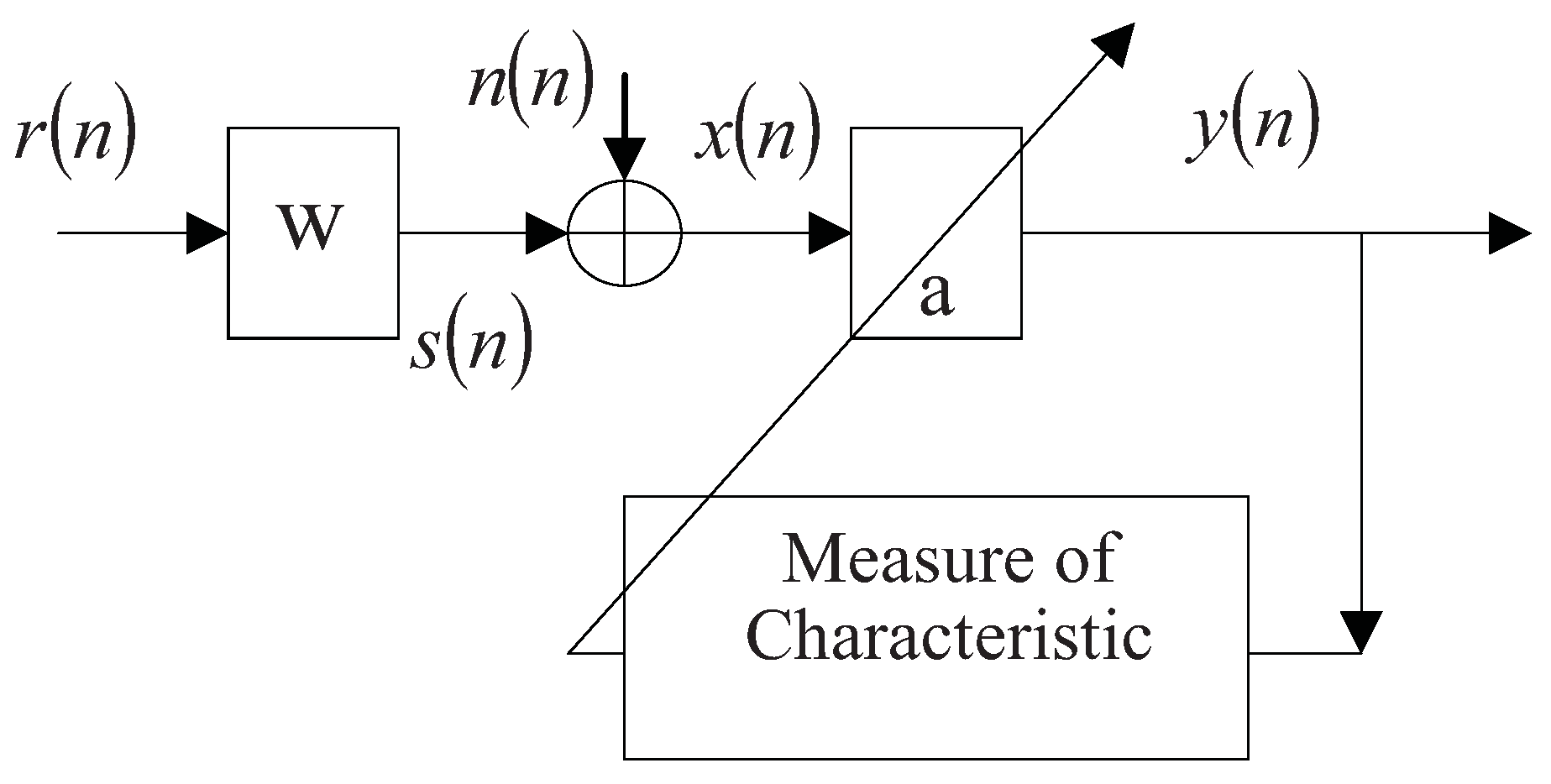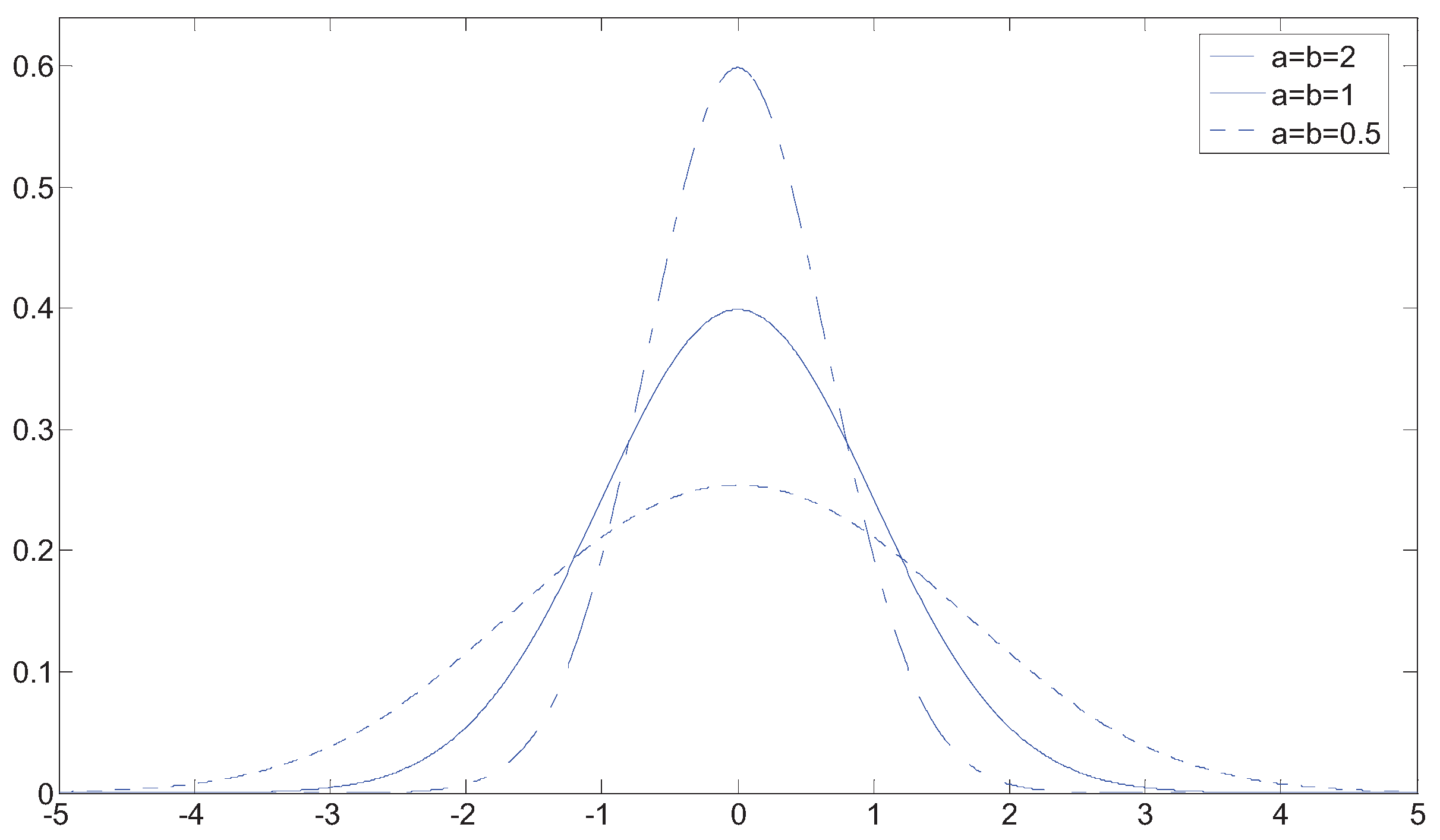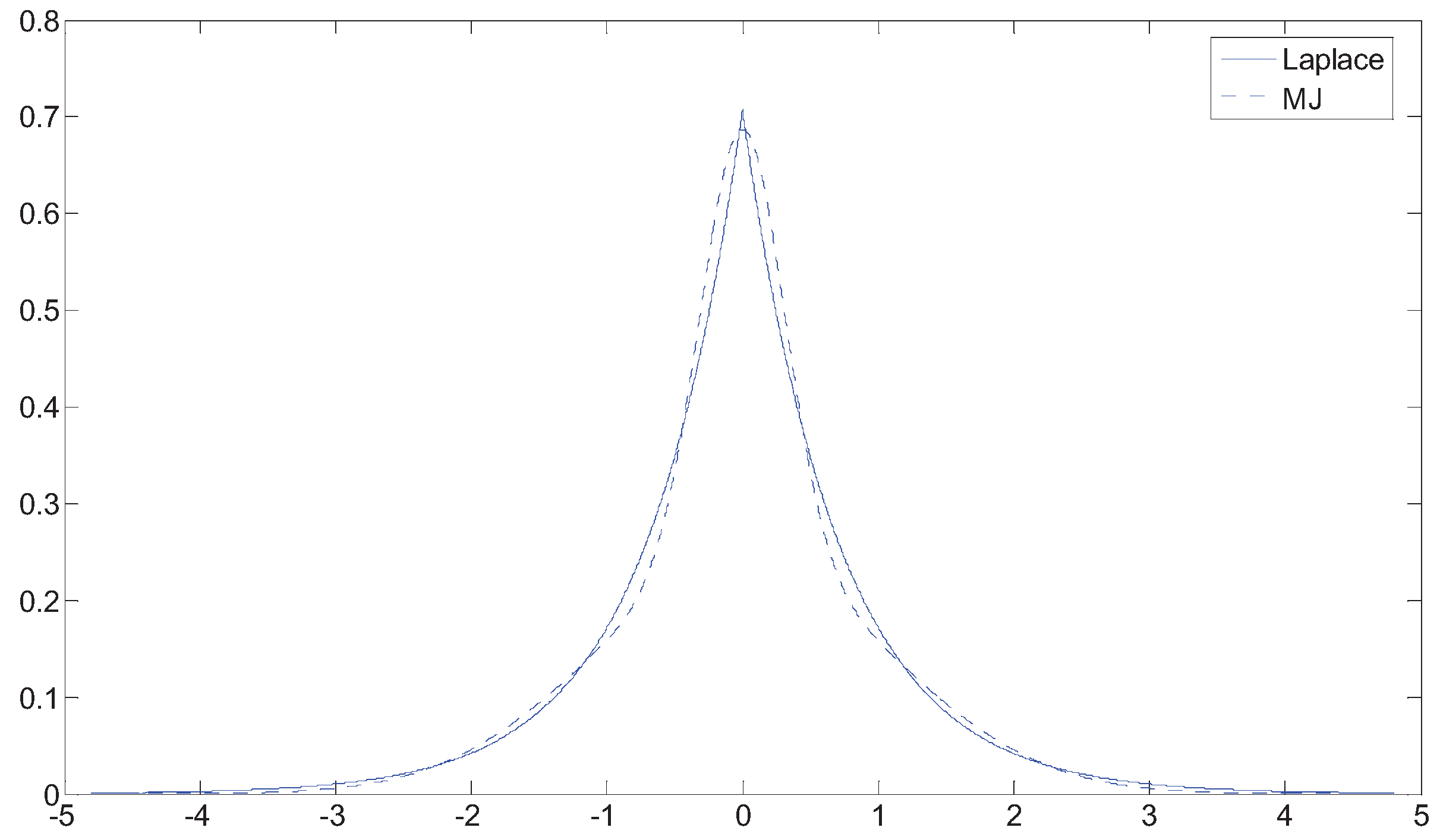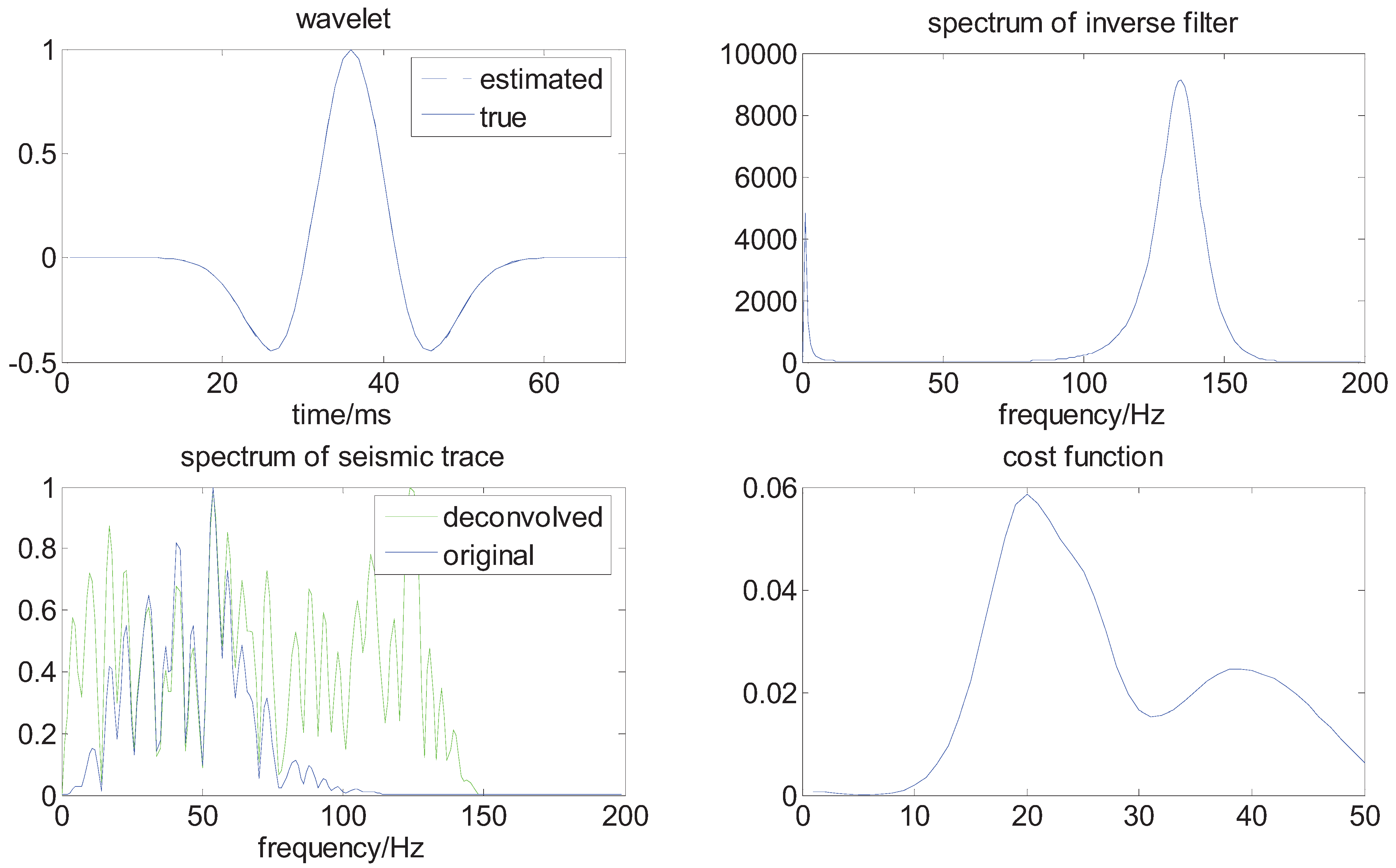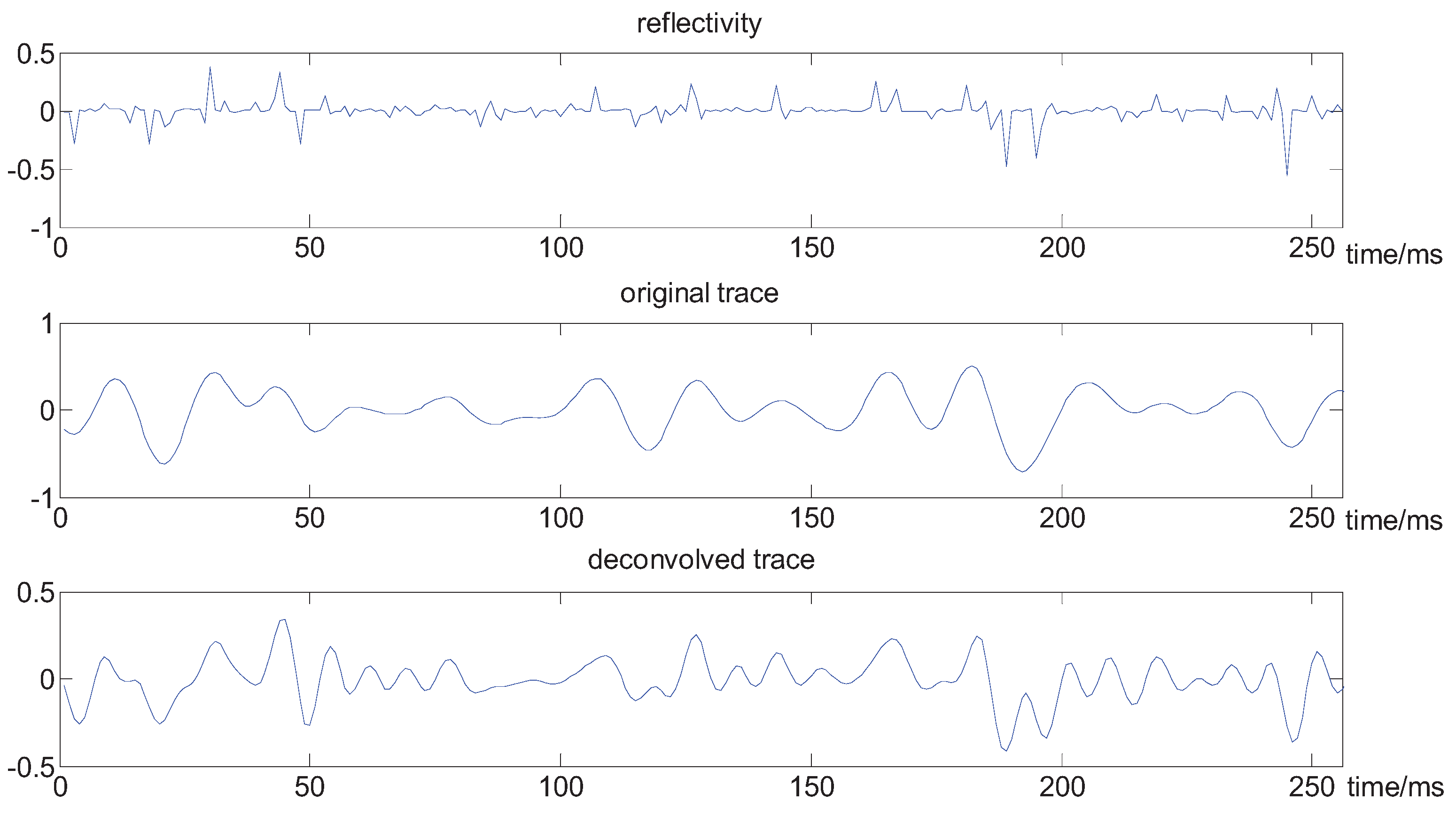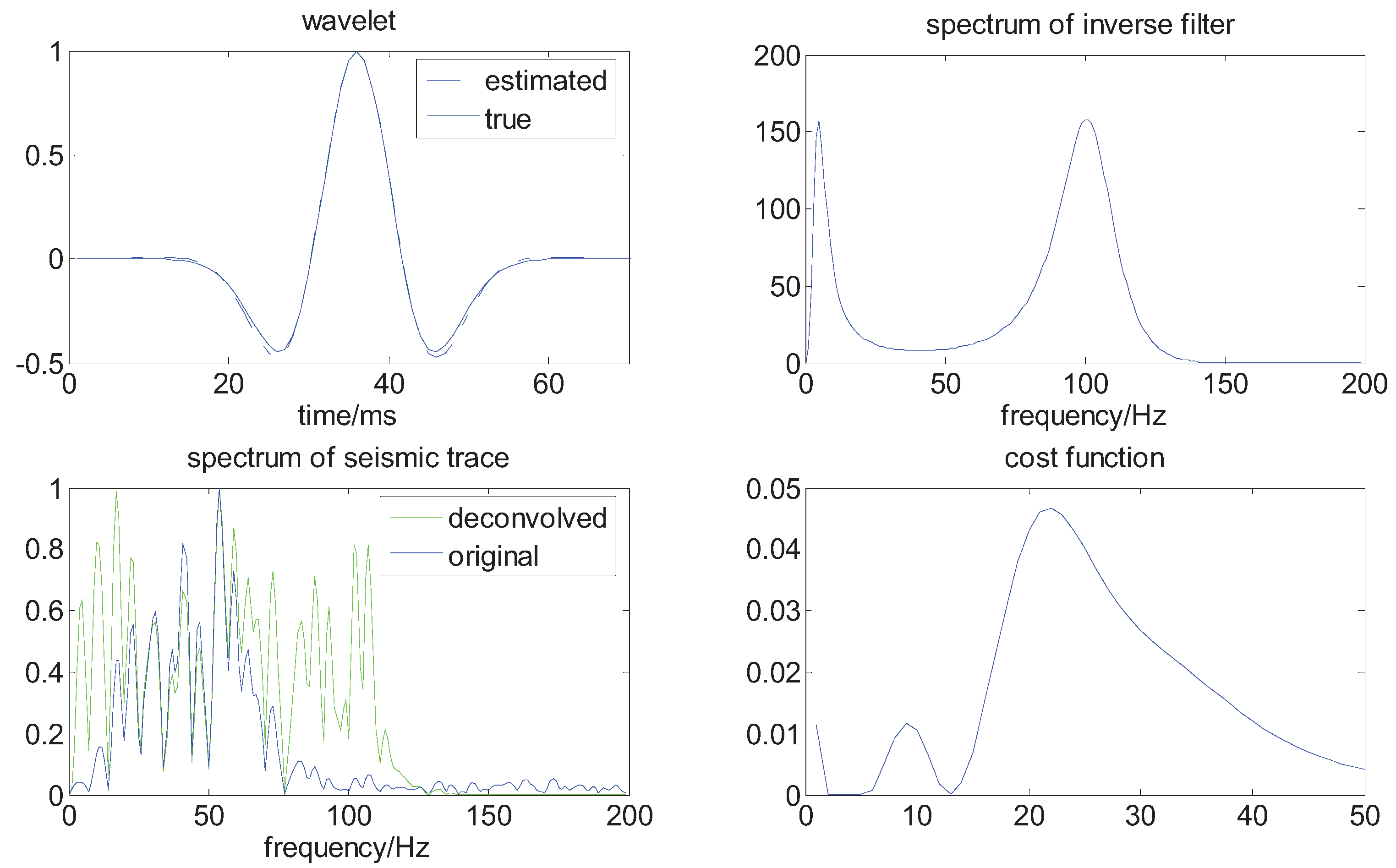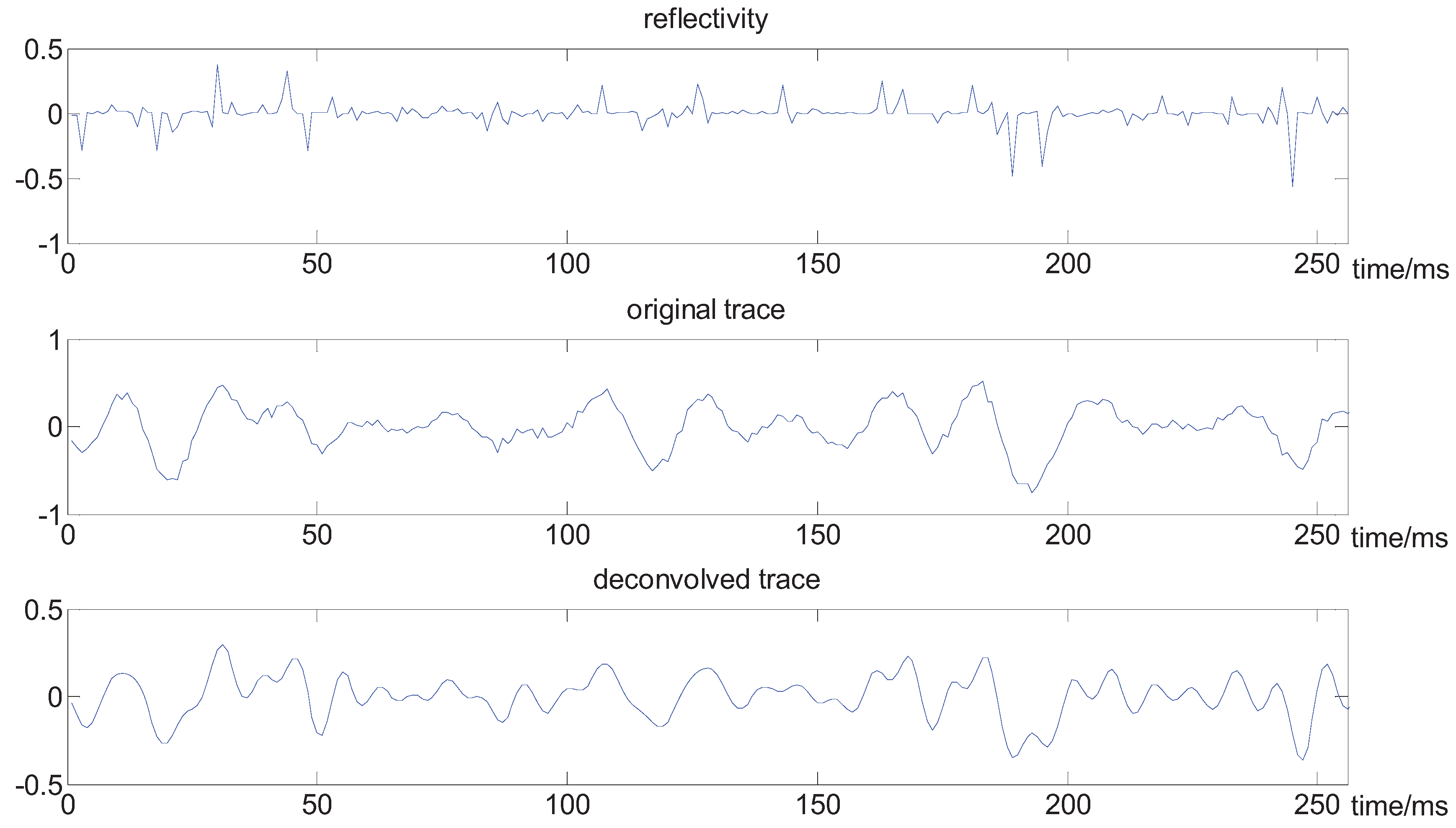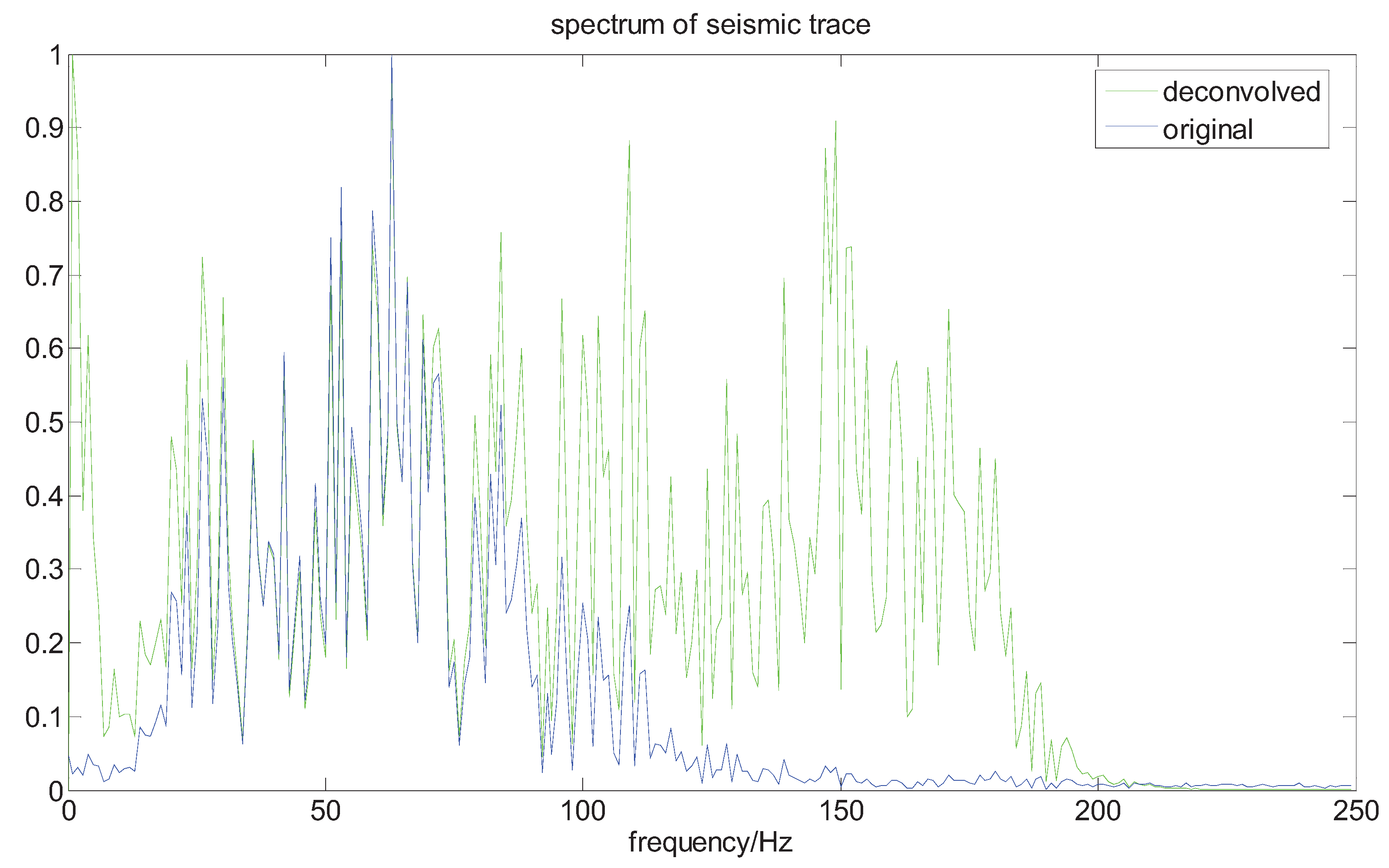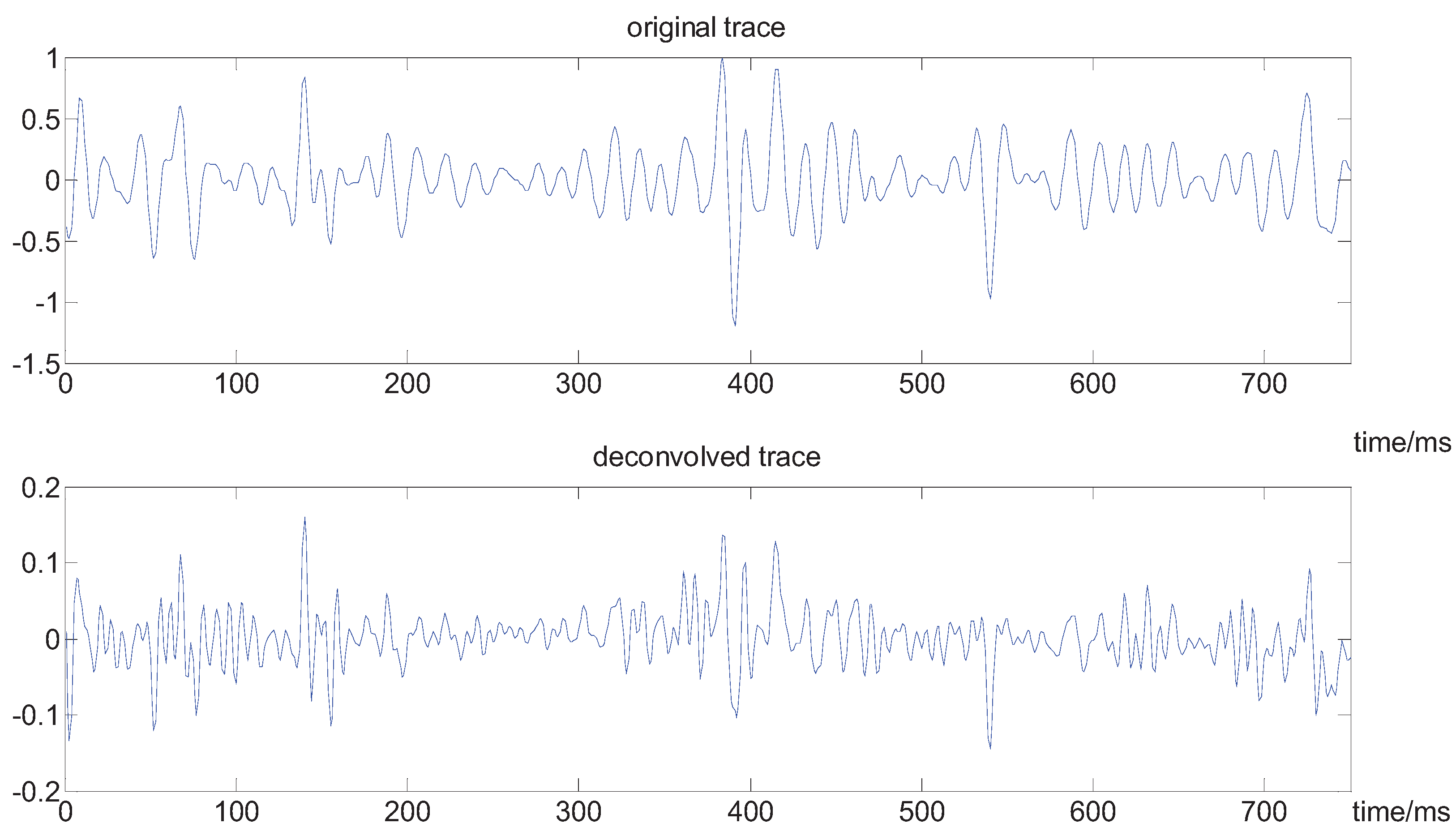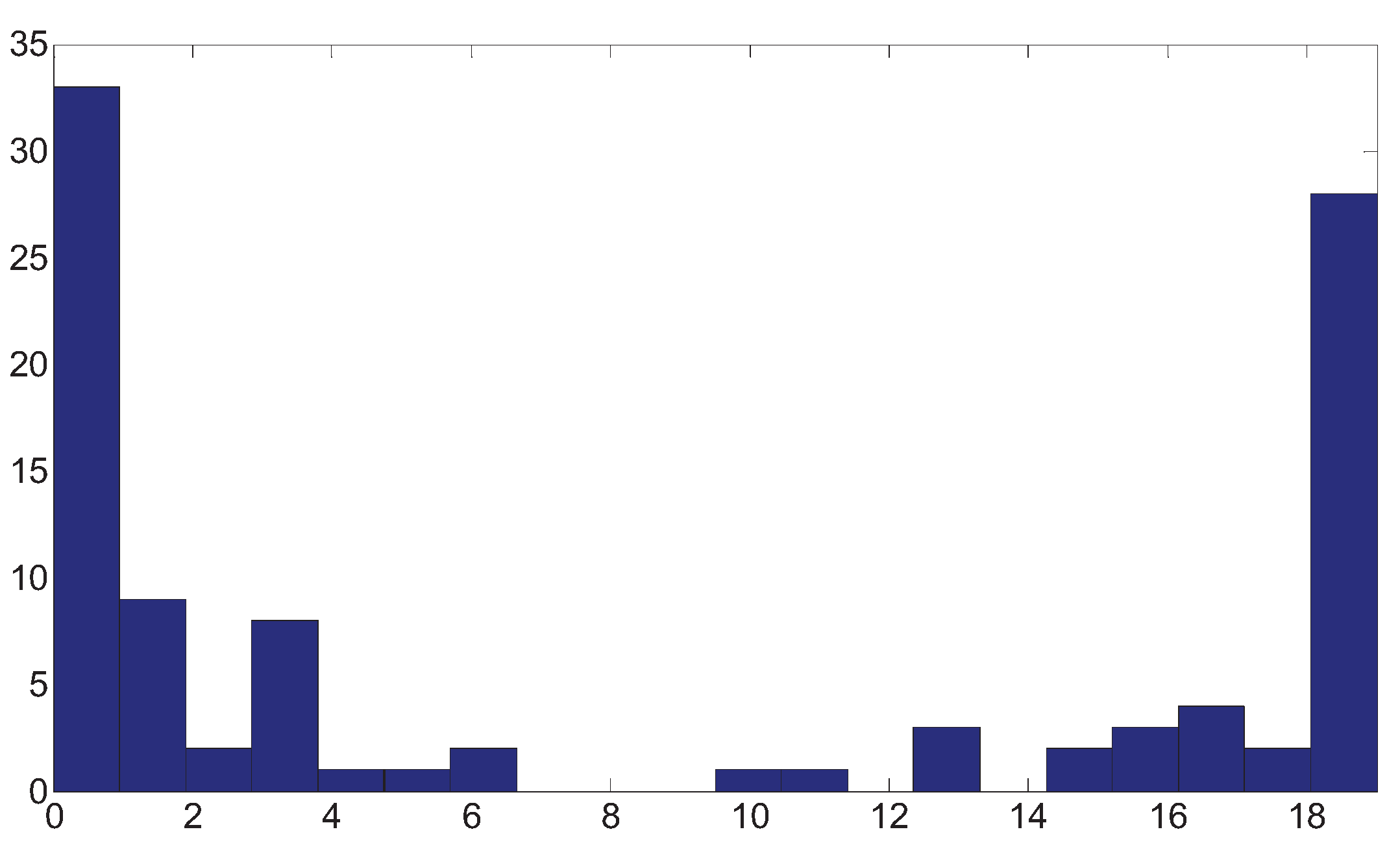1. Introduction
In seismic exploration, a seismic signal (e.g., recorded trace) is often represented as the result of a superposition of wavelets of constant shape weighted by the reflectivity series, thus it can be modeled as a convolution between the source signature (the embedded wavelet) and the reflectivity series. Deconvolution is an important process by which the reflectivity series can be estimated from the recorded trace, and vertical resolution of the seismic image will be enhanced.
For the above convolution model, when the wavelet is known, estimation of the reflectivity series is called deterministic deconvolution, which is done by least-squares, or in a Bayesian framework adding some priors on the reflectivity distribution.
As the wavelet is unknown, we have the classical blind deconvolution problem; statistical deconvolution appears to be a powerful tool for dealing with practical situations. Various approaches to statistical deconvolution have been proposed and applied in recent decades, including the expectation maximization (EM) algorithm, the higher-order statistics (HOS) algorithm, and the general purpose information criteria algorithm (GPIC).
The EM algorithm is an effective method for maximum-likelihood estimates, which are mainly used to estimate parameters from incomplete data. Since Mendel introduced the Bernoulli–Gaussian (BG) model as the distribution of reflectivity [
1], a few approaches, based on the EM algorithm and BG model, have been published [
2,
3]. BG is a simple form of the Gaussian Mixture Model, which makes the likelihood function be expressible in closed form. The EM algorithm has shown good performance in the blind deconvolution context; whereby the estimation problem for the wavelet and reflectivity can be solved in an incomplete data set (the lack of localization and magnitude of the reflectivity). For the real field data, the reflectivity sequence changes do not always appear as clearly as predicted by the BG model [
4], therefore, the sparse nature of the input signal is not a sufficiently robust hypothesis for good system estimation. On the other hand, it may be possible to extend the BG model to a more complicated probability density, however, the resulting expressions of the likelihood function will be handled inconveniently, adding obstacles for its use.
The higher-order statistics which we use are known as cumulants. The cumulant matching (CM) method has been developed for estimating a mix-phase wavelet from a convolutional process. Matching between the trace cumulant and the wavelet moment is done in a minimum mean-squared error sense under the assumption of a non-Gaussian, stationary and statistically independent reflectivity sequence. The main difficulty of this approach is that it requires a large amount of data to achieve reliable estimations [
5]. But, in general, seismic data is arguably always nonstationary since anelastic attenuation processes are present everywhere, a seismic signal is shown to be approximately stationary just within a time window, in which the real signal is finite in length, leading to limited performance with this approach.
The GPIC algorithm has been intensively studied by many researchers for a large number of applications over the last couple of decades. In the seismic application, a seismic trace
may be written in the form:
where
denotes the convolution,
,
,
represent the wavelet, reflectivity, and superposed noise respectively. The idea of general purpose information criteria algorithm is to find an inverse filter
to create an output:
which looks like the reflectivity series, the inverse filter can be obtained by optimizing some criterion related to the output characteristic.
Figure 1 depicts such a convolution-deconvolution system.
Figure 1.
Convolution-deconvolution system.
Figure 1.
Convolution-deconvolution system.
The earliest technique for this kind of algorithm was introduced by E.A. Robinson [
6], and is based on the assumptions that the reflectivity sequence is a Gaussian white noise, and the wavelet is minimum phase. Since the pioneering work of Agard and Grau [
7], it has been generally recognized in exploration geophysics that the reflectivity typically has a non-Gaussian distribution. Many techniques have been developed to exploit the nonGaussianity of seismic data for blind deconvolution based on information theory, among which excellent contributions were made by Wiggins, Claerbout, Gray, Ooe and Ulrych, Godfrey, Donoho, and Levy and Oldenburg [
8,
9,
10,
11,
12,
13,
14],
etc. For a more detailed discussion of their studies, see Walden [
15].
Larue, Mars, and Jutten proposed a new blind single-input single-output (SISO) deconvolution method based on the minimization of the mutual information rate of the deconvolved output [
4]. The mutual information has the nice property of being positive and it vanishes if and only if the components of deconvolved output are mutually independent, by which a good criterion for blind deconvolution can be obtained. They estimate deconvolution filter in the frequency domain. To take the band limited nature of seismic wavelets and the presence of noise into account, Baan and Pham presented a modification of the mutual-information rate, whitening the deconvolution output only within the wavelet pass band [
16]. Their approach estimates the wavelet by maximizing the negentropy of the deconvolved output, and to prevent noise amplification, Wiener filtering is invoked.
Generally speaking, if a wavelet has no zeros on the unit circle, blind deconvolution is a well posed problem, but if it has zeros on the unit circle, then the problem is ill posed, in which the only criterion to apply to inverse filter is to maximize the nonGaussianity of the deconvolved output according to the central limit theorem, provided the distribution of reflectivity is non-Gaussian and non-infinite divisibility. In Van der Baan and Pham’s work, they use negentropy as a criterion to perform deconvolution, which is defined as the Kullback-Liebler divergence between the density and the normal equivalent i.e. with the same mean and variance.
In statistics and information theory, Kullback-Liebler divergence is just one of information measures to show the difference of two distributions, Csiszár (and independently also by Ali and Silvery) introduced the f-divergence yielding a generalized family of invariant measures, which is given by [
17]:
for convex
, and
, where
and
are two probability density functions (PDF). For
, the f-divergence reduces to the classical Kullback-Liebler divergence.
Considering a real value convex function
defined on
, from classical Jensen inequality:
we have:
Equality holds if and only if . If we use to denote the PDF of the deconvolution output, and let be a PDF of the normal distribution with the same variance as that of , then f-divergence is nonnegative and scale invariant, and will become larger as the deconvolution output goes off the Gaussianity, which provides an appealing method to build an information criterion.
In the above entropy-based approaches by Larue, Mars, and Jutten, Baan and Pham, one key point is to estimate the PDF of the deconvolution output, therefore, Pham designed a fast algorithm to obtain the PDF and score function for blind source separation application. However, as a nonparametric method, Pham’s fast algorithm needs certain length of the data to provide a good estimation, in their deconvolution examples, the length of the input data is usually over 500. As mentioned above, a seismic signal is treated to be stationary just within a limited time window due to the intrinsic attenuation of the earth medium, these entropy-based approaches seem to result in a limited performance in the case of short data records.
Another point for the above approaches is that the number of iterations depends strongly on the choice of initialization of inverse filter, as most optimization programs do. Thirdly, to improve the stability and the performance of the algorithm, some constraints need to be placed on the inverse filter when deconvolution criterion are to be proposed, which can bring in some artifacts.
Inspired by Larue, Mars, and Jutten, Baan and Pham’s works, this paper aims at constructing new criterion based on Csiszár f-divergence for seismic deconvolution, and proposes a new blind deconvolution algorithm. This new method can handle data with small samples, which means it has ability to deal with nonstationary data. We believe this approach is novel for several reasons:
To facilitate estimating the PDF of the deconvolution output, we use mixture Jones’ family of distributions (MJ) to model the PDF of the output, by this way; the PDF to be estimated can be generated with only several parameters;
We derive the closed form formula for one kind of Csiszár f-divergence by applying MJ distribution, from which a new criterion for blind deconvolution can be constructed;
We apply the wavelet model derived by Neidell to design the inverse filter; this wavelet model has two shape parameters. If we know the dominant frequency of the wavelet, only one parameter is left, which means the optimization program for multivariate reduces to univariate case without setting initialization and adding constraint on inverse filter.
The rest of the paper is organized as follows. In
Section 2 we briefly introduce the MJ distribution. Based on the MJ distribution, in
Section 3, we derive one of the Csiszár f-divergences in closed form. In
Section 4, we introduce the parameter estimation of this MJ distribution from the real data. After briefly introducing the wavelet model derived by Neidell in
Section 5, we describe our deconvolution procedure in
Section 6. Examples illustrating the effectiveness of our approach are given in
Section 7. Finally, we give a briefly discussion on the wavelet phase estimation in
Section 8. We give the conclusions in
Section 9.
8. Discussion
In our simulation experiments, the wavelet is zero phase, which means that our method performs well for zero-phase deconvolution. Zero-phase deconvolution, also denoted as pure-amplitude deonvolution, leaves the phase of original seismic section undistorted after deconvolution, i.e. with no time shift. However, in the blind deconvolution context, it is important for an algorithm to estimate well the phase of the wavelet. Theoretically, if a wavelet is reversible, i.e., no zeros on the unit circle, its phase can be uniquely determined (or a linear phase shift is left) by the non-Gaussianity maximization of the deconvolved output, As far as the irreversible wavelet, i.e., band-limited wavelet, is concerned, to our knowledge, there are no sound theoretical reasons for determining the phase of the wavelet uniquely.
To test the performance of these information-based approaches for the band-limited wavelet phase estimation, we designed the following experiment. Firstly we use a band-pass filter with constant phase to approximately model the spectrum of the deconvolved wavelet, which takes the form:
where if the frequency of the band-pass filter is positive, the plus sign is taken.
Secondly, we apply this band-pass filter bank to a reflectivity, and get a series of outputs; it is immediate that the information distance is the function of . After having computed the information distances corresponding to different , we can find the unique , for which the information distance achieves its peak value. If or , it shows that the algorithm based on the non-Gaussianity maximization can make a good estimation for the phase of the band-limited wavelet. Finally, we independently perform the above experiment many times to obtain a numerical result.
Considering the real situation, in which the dominant frequency of the wavelet is low, we choose a Ricker wavelet with a central frequency 40 Hz, hence, the high frequency of the band-pass filter is 120 Hz, in the meantime, we set the low frequency as 5 Hz, and
. The reflectivity contains 256 sampling points, and is generated as
, where
are independent normal random variables with zero mean and variance 0.28. The result of 100 independent trials is plotted in
Figure 11.
Figure 11.
The histogram of .
Figure 11.
The histogram of .
Form the histogram of , it can be shown that about 60% of the take the value of or , there is still some randomness in the phase estimation in the case of band-limited seismic data with a low dominant frequency and short data records.
